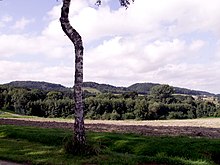Little Selberg
| Little Selberg | ||
|---|---|---|
|
NSG Kleiner Selberg north side |
||
| height | 271.7 m above sea level NN | |
| location | Vlotho , North Rhine-Westphalia , Germany | |
| Mountains | Lipper mountain country | |
| Coordinates | 52 ° 7 '13 " N , 8 ° 52' 34" E | |
|
|
||
The Kleine Selberg is a mountain with a height of 271.7 m above sea level. NN in Vlotho . The mountain is located in the east of the district Valdorf . It is one of the ten highest mountains in the Herford district . Naturally, it belongs to the Weser Uplands and the Lipper Mountains . Directly west of the Kleiner Selberg is the somewhat higher Große Selberg . To the southeast are the Bonstapel and the Nettelberg . The Linnenbeeke , which rises at the Bonstapel, flows to the east .
In 1971, a nature reserve Kleiner Selberg was designated and in 1998 a new designation took place in the Vlotho landscape plan . The nature reserve (NSG) has a size of 13.6 ha . It borders on the Linnenbeeke nature reserve and, like the Eiberg nature reserve, protects a juniper heather , forests and poor pastures on the mountain and in an adjacent stream valley. The number of junipers up to four meters high was estimated at over 1,000 in 2013. On the northern slope, there is mainly a dwarf shrub heather characterized by blueberries , the upper part of which is covered with numerous junipers. The protected mountain fern and rib fern can also be found . On the eastern slope there are more nutrient-rich meadows and pastures.
fauna
In the NSG, the rare species such as red-backed shrimp , tree pipit , small fire butterfly and field cricket were detected.
Protective measures in the nature reserve
In the 1930s, the Kleine Selberg was almost bare. In the 1930s, the steeper slopes to the west were planted with trees. After that, trees began to spread in many areas. The Herford district bought the heather areas on the northeast side of the mountain. The circular areas are regularly de-puss, so trees are removed. Sheep grazing in the past has only been carried out sporadically in recent decades. 2008 and 2009 ever with an excavator and other equipment a face abgeplaggt . The top soil layer with vegetation was removed and transported away. The unfinished floor was covered with heather from the Senne interspersed. A repopulation of these areas with heather should be encouraged. In 2011 there was another litter with heather, as many small heather seedlings had dried out in the dry summer of 2010. The raw soil areas were actually populated by many heather seedlings. The plagging campaign was funded by the state of North Rhine-Westphalia and the EU. Further protective measures are planned. Meadow areas are used extensively in the south and south-east of the NSG. According to the provisions of the contractual nature conservation, they are no longer fertilized and only mowed after June 15.
literature
Heinz Lienenbecker: Comparative studies in some nature reserves in the Herford district (Eiberg, Kleiner Selberg, Linnenbeeke). Ber. Natural science Association f. Bielefeld u. Environment 51 (2013): 80-109
See also
Web links
- "Kleiner Selberg" nature reserve in the specialist information system of the State Office for Nature, Environment and Consumer Protection in North Rhine-Westphalia



